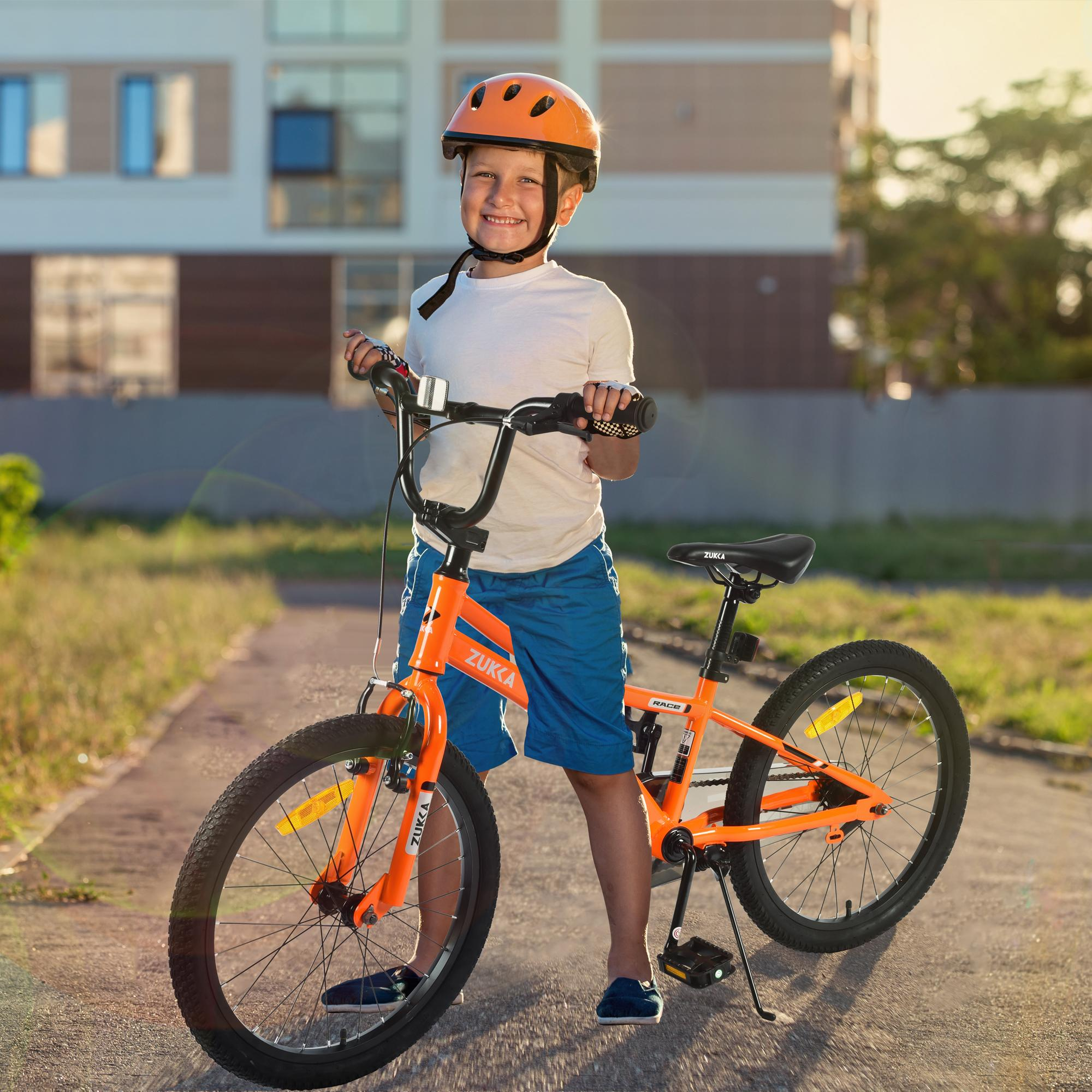Want your bike to last longer and ride better? Start with these 5 beginner-friendly maintenance tips:
- Check Tire Pressure: Keep tires at the right PSI for smoother rides and safety.
- Clean & Lubricate the Chain: Prevent wear and ensure smooth pedaling.
- Inspect Brakes: Check for squeaks, weak stopping power, or worn pads.
- Tighten Bolts: Secure handlebars, seat post, pedals, and wheels.
- Keep Your Bike Clean: Regular cleaning prevents rust and catches early issues.
These simple steps don’t require advanced tools and can save you time, money, and hassle. Let’s dive into the details to keep your bike in top shape!
3 Essential Bike Maintenance Tips For Beginners
Tip 1: Check and Adjust Tire Pressure
Tire pressure plays a key role in your bike's comfort, safety, and performance. You can find the recommended pressure range on the sidewall of your tires.
Finding the Right Tire Pressure
Road bike tires usually require 80-130 PSI, while mountain bike tires typically need 25-35 PSI. The ideal pressure depends on a few factors:
| Factor | Recommendation |
|---|---|
| Rider Weight | Heavier riders need higher pressure |
| Terrain Type | Lower pressure improves grip on rough terrain |
| Tire Width | Wider tires work better with lower pressure |
Steps to Check and Inflate Tires
- Take off the valve cap.
- Use a bike-specific pressure gauge to measure.
- Inflate to the recommended range using a pump with a built-in gauge.
- Always check pressure when the tires are "cold" (before riding).
It's important to check tire pressure when the tires are cold because riding heats them up, which can temporarily increase the pressure by up to 10%.
How Often to Check Tire Pressure
Keeping an eye on tire pressure is just as important as maintaining your chain (we'll cover that in Tip 2). Research shows that while 70% of cyclists check their tire pressure weekly, this might not be enough. Here's a better routine:
- Check before any long ride.
- For frequent riders, check weekly.
- After significant temperature changes, recheck pressure.
Properly inflated tires ensure a smoother ride and better safety. Once you've got your tires sorted, it's time to focus on your chain care.
Tip 2: Clean and Lubricate the Chain
Once you've checked your tire pressure (Tip 1), it's time to focus on the chain - arguably the most important moving part of your bike. Keeping it clean and properly lubricated helps prevent wear and ensures smooth, efficient rides.
Why Taking Care of Your Chain Is Important
A neglected chain can ruin your ride. Dirt and grime act like tiny abrasives, wearing down the chain and drivetrain components over time. This not only makes shifting gears harder but can also lead to costly repairs down the line.
Steps to Clean Your Chain
Chain maintenance doesn't have to be complicated. Here's a quick guide:
- Secure your bike in an upright position.
- Use a rag and a degreaser to grip the chain while backpedaling until it's free of dirt and grime.
- Once clean, dry the chain thoroughly to prepare it for lubrication.
How to Lubricate Your Chain
Pick the right lubricant for your riding conditions - dry lubricants work well in normal weather, while wet lubricants are better for rainy or muddy rides. Apply a small amount of lubricant to each chain link as you backpedal. After about two minutes, wipe off any excess to prevent dirt from sticking.
A clean, well-lubricated chain keeps your bike running smoothly. Next, let's talk about keeping your brakes in top shape.
Tip 3: Check and Adjust Brakes
Keeping your brakes in good condition is essential for both safety and a smooth ride. Just like taking care of your chain, proper brake maintenance can make a big difference in how your bike performs.
Signs Your Brakes Need Attention
Watch out for these red flags:
- Squealing or squeaking when you apply the brakes
- Weaker stopping power than usual
- Uneven feel when braking
- Grinding noises, which can signal serious wear
How to Adjust Disc and Rim Brakes
The steps to adjust your brakes depend on the type you have:
-
Disc Brakes:
- Inspect the brake pads: Check if the pads are thick enough. Thin pads need replacing.
- Center the calipers: Loosen the caliper bolts, squeeze the brake lever to align the caliper with the rotor, and then tighten the bolts evenly in a star pattern.
-
Rim Brakes:
Make sure the brake pads are aligned with the rim surface and that both pads are evenly spaced when the brakes are released.
When to Call in a Pro
Certain brake issues are best left to a professional mechanic, such as:
- Leaks in hydraulic systems
- Worn-out rotors or rims
- Brake fluid replacement
- If you're unsure how to make adjustments
Once your brakes are in top shape, you can turn your attention to checking the bike's structural integrity by tightening bolts as needed.
sbb-itb-4ec432b
Tip 4: Tighten Loose Bolts and Parts
Once your brakes are in good shape (Tip 3), it's time to check the rest of your bike's structure. Loose bolts can cause safety problems and reduce performance, so keeping everything secure is a must.
Key Areas to Inspect
Pay close attention to these critical parts:
- Handlebars: Check the stem bolts and handlebar clamp bolts.
- Seat Post: Inspect the collar bolt and saddle rail clamps.
- Pedals: Ensure they're securely attached to the crank arms.
- Wheels: Examine quick-release skewers or axle nuts.
Using a Torque Wrench the Right Way
A torque wrench ensures bolts are tightened to the correct level:
- Refer to the manufacturer's torque specifications.
- Adjust the wrench to the specified value.
- Tighten until you hear or feel the "click."
Be careful not to overtighten - this can strip threads or damage parts. Undue force is just as risky as leaving bolts too loose.
When to Check Bolts
Stick to this schedule for inspections:
- Weekly: Check key bolts.
- Monthly: Perform a complete inspection.
- After rough rides: Inspect immediately.
With the key components secure, you're one step closer to keeping your bike in top condition.
Tip 5: Keep Your Bike Clean
Once you've tightened all the bolts (Tip 4), it's time to focus on keeping your bike in top shape with regular cleaning. A clean bike not only performs better but also helps you catch potential problems early.
Quick Cleaning After Rides
Make it a habit to clean your bike right after each ride. Here's how:
- Wipe the frame with a soft cloth to get rid of dirt and sweat.
- Brush the chain to remove grime and prevent buildup.
- Check mud-prone spots and clean them before dirt hardens.
This quick 5-minute routine will save you time and effort in the long run.
Deep Cleaning for Better Performance
Every 1-2 weeks, give your bike a more thorough cleaning. Use these tools:
- Mild soap and a brush for the frame.
- Degreaser to clean the drivetrain.
- Alcohol wipes for brake components.
- Soft sponge for the wheels.
After washing, make sure to dry your bike completely to avoid rust, paying extra attention to the chain and other metal parts.
Key Areas to Focus On
Concentrate your cleaning efforts on components that experience the most wear and tear:
- Drivetrain: Includes the chain, cassette, and derailleurs.
- Brake components: Keep these clean for reliable stopping power.
- Mud-prone spots: Areas like the bottom bracket and pedals.
- Cable connections: Dirt here can affect performance.
Avoid using high-pressure water, as it can force moisture into bearings and cause damage. Stick to a gentle stream of water and use bike-specific cleaning tools to protect your components. Once everything is dry, don’t forget to apply lubricant as mentioned in Tip 2.
Wrapping Up: Building Confidence in Bike Maintenance
Key Takeaways for New Riders
Learning how to handle tasks like tire care, chain upkeep, brake checks, bolt tightening, and cleaning will give you the tools to take better care of your bike. These simple routines not only enhance your bike's longevity but also keep you safer on your rides.
Paying regular attention to these areas helps you avoid issues before they escalate. Each task has a clear purpose - whether it's keeping your bike performing well or avoiding expensive fixes. With time and practice, these habits will become second nature, making bike maintenance feel less like a chore.
What’s Next for Smoother Rides
Stick to these five tips to build solid maintenance habits. Keep essentials like a pressure gauge, chain lube, and a torque wrench handy. Use a calendar to track maintenance schedules and stay consistent.
Mastering these basics isn’t just about saving money on repairs - it’s about ensuring every ride is as safe and enjoyable as possible. Regular upkeep lets you spot potential problems early, keeping your bike in top shape for the long haul.
FAQs
How do you maintain a bike for beginners?
Follow the ABC basics before every ride:
- Air: Use a pressure gauge to check tire pressure and make sure it matches the PSI listed on the tire's sidewall.
- Brakes: Test how well the brakes respond and check for any wear on the pads.
- Chain: Ensure the chain is clean and properly lubricated.
These checks are essential for keeping your bike in good shape. Pair them with the five core maintenance tips mentioned earlier for thorough care. For more complex systems like hydraulic brakes, schedule a professional tune-up every six months.
How do I know if my bike chain needs lube?
Look for these signs to determine if your chain needs lubrication:
- It squeaks when you pedal.
- You see rust or dry spots.
- The chain feels stiff.
- There's a lot of dirt buildup.
To check, wipe the chain with a rag - if it leaves behind a lot of dirt, it’s time for a cleaning. Use a stiff brush to clean between the links, then apply lubricant carefully to each roller as explained in Tip 2.


